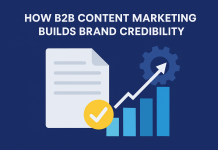For years, digital marketing has depended on third-party cookies to understand user behavior, retarget potential buyers, and optimize online campaigns. These small tracking identifiers quietly powered most of the online advertising ecosystem. But today, the digital world is facing a profound shift. With increasing privacy regulations, modern browser restrictions, and the global move toward consent-driven data practices, third-party cookies are rapidly losing relevance. As this change accelerates, one form of data is emerging as the most powerful and sustainable foundation for the future of digital marketing: first-party data.
This transformation is much more than a technical update. It is redefining how companies, especially B2B organizations, approach audience understanding, personalization, and lead generation. A world without third-party cookies requires a fundamentally different strategy, one that prioritizes transparency, trust, and deeper customer relationships. And at the center of that strategy lies the need to build, nurture, and activate first-party data in ways that create long-term competitive advantage.
The Rise of First-Party Data and the Fall of the Cookie Era
To understand the urgency around first-party data, it’s important to recognize why third-party cookies are fading. For more than two decades, they operated quietly in the background, enabling marketers to track user activities across multiple websites. However, as consumers became more aware of how extensively their online behavior was being monitored, concerns over privacy escalated. This awareness, along with strict global regulations such as GDPR, CCPA, and India’s Digital Personal Data Protection Act, sparked a fundamental rethinking of how data should be collected and used.
Browsers also played a key role in accelerating the decline. Safari and Firefox blocked third-party cookies years ago, and with Google Chrome moving toward a complete phase-out, the final chapter of third-party cookies is already being written. In this environment, businesses can no longer rely on external data brokers or cross-site tracking to fuel their marketing strategies. Instead, they must shift toward data sources they can collect ethically, transparently, and directly, sources that empower them to maintain privacy compliance while still understanding their audience deeply.
This is exactly where first-party data becomes indispensable.
What Makes First-Party Data So Valuable Now
First-party data refers to information that a business collects directly from its customers and audience. Whether it’s gathered from website behavior, CRM interactions, email responses, app usage, webinar participation, or form submissions, this data is owned entirely by the company. It is consent-based, highly accurate, and more relevant to actual buyer behavior compared to external datasets.
As third-party cookies disappear, first-party data becomes the backbone of a brand’s marketing engine. It offers unprecedented clarity into audience interests, intent signals, engagement patterns, and buying readiness. Because it is tied directly to a brand’s own digital properties, first-party data provides a more holistic and trustworthy picture of the customer journey.
Moreover, this shift creates a fairer ecosystem, one where brands must earn the right to collect data by offering value, transparency, and personalization. This dynamic ultimately strengthens the relationship between brands and users, making marketing more relevant and less intrusive. Businesses that master the collection and application of first-party data will be able to personalize at scale, create richer experiences, and design smarter campaigns that reflect real user needs rather than broad assumptions.
Why First-Party Data Matters Even More in B2B
While first-party data is important across all industries, its impact is particularly significant in B2B. B2B buying journeys are longer, more complex, and involve multiple stakeholders. Decisions are rarely impulsive; they require research, trust building, and repeated interactions across different touchpoints. In such an environment, third-party data was never enough to fully understand intent or readiness. It offered breadth but not depth.
First-party data, on the other hand, reveals granular insights about how prospects engage with content, how often they revisit product pages, which assets they download, and what types of information they seek. These signals help marketers understand where an account is in the buying cycle and what type of engagement would be most effective. When captured consistently, first-party data transforms into a powerful resource for account-based marketing, personalized content delivery, and targeted lead nurturing.
Additionally, B2B marketers rely heavily on relationship building. First-party data strengthens this process by enabling more relevant and respectful communication. Every email sent, campaign launched, or sales outreach conducted becomes more meaningful when it is driven by data that reflects real behavior rather than assumptions.
The Growing Role of Trust and Transparency
In the post-cookie environment, trust becomes a currency. When users share their information directly with a brand, they expect transparency about why it is being collected and how it will be used. Businesses must therefore embrace consent-first practices, clear opt-ins, transparent privacy policies, and responsible data governance.
This shift encourages marketers to move from tracking users without their knowledge to building relationships based on value exchange. When a user downloads a whitepaper, attends a webinar, signs up for a newsletter, or interacts with a chatbot, they share information because they believe the brand can offer something useful in return. This makes first-party data not just more ethical, but more informative and actionable.
Moreover, as businesses invest in stronger data governance frameworks and consent mechanisms, they create a more secure and compliant ecosystem that benefits both the organization and its customers.
How First-Party Data Fuels Better Marketing Experiences
The transition to first-party data is not simply about replacing one technology with another. It fundamentally elevates how brands design user experiences.
By analyzing first-party data, businesses can identify patterns in customer behavior, anticipate future needs, and tailor messaging with greater precision. Personalization becomes more contextual and less intrusive because it is based on voluntary interactions. Content strategies become sharper because marketers can clearly see which topics resonate and which ones do not. Lead scoring becomes more accurate because every action taken by a prospect contributes to a richer understanding of their intent.
Additionally, first-party data enables brands to deliver consistent and connected experiences across channels. Whether a user interacts with email, the website, a sales representative, or a product demo, the brand can maintain continuity because the insights come from a unified data source.
How B2B Companies Can Build a Strong First-Party Data Foundation
The ability to leverage first-party data effectively depends on the systems and processes a company establishes. Successful organizations begin by optimizing their digital touchpoints so they can collect meaningful information seamlessly. A website that encourages engagement through intelligent forms, chat interactions, and valuable resources becomes a key contributor to data generation. Webinars, events, and interactive tools further enrich the data pool by capturing additional layers of insights.
A centralized CRM becomes essential, serving as the core repository where all first-party data is organized and connected. When integrated with marketing automation systems, it provides a clear picture of buyer behavior across the entire funnel. Moreover, advanced platforms such as Customer Data Platforms (CDPs) help unify information from different channels and create well-defined audience segments, which marketers can use to deliver personalized experiences at scale.
Additionally, email marketing remains one of the most effective channels for gathering and nurturing first-party data. Since every interaction, from clicking a link to completing a survey, contributes behavioral insights, email becomes a powerful engine for both engagement and data enrichment.
The Role of AI in Maximizing First-Party Data
As first-party data becomes more central to marketing, artificial intelligence plays an increasingly important role in unlocking its full potential. AI helps marketers process large datasets, identify patterns, and make predictions that were previously impossible through manual analysis. It can reveal hidden correlations in behavior, anticipate future actions, and recommend personalized content pathways for each prospect.
In B2B lead generation, AI-driven models can evaluate intent signals, score leads more intelligently, and forecast the likelihood of conversion. This allows marketing teams to prioritize resources more efficiently, while sales teams receive higher-quality leads backed by data-driven insights. In many ways, AI amplifies the value of first-party data by transforming raw information into actionable intelligence.
The Challenges Businesses Must Overcome
Even though first-party data holds immense value, adopting it is not without challenges. Many organizations still operate with fragmented data systems, where information is stored in isolated silos across different teams and platforms. This fragmentation makes it difficult to create a unified view of the customer journey.
Another challenge is the volume of data. Smaller businesses or companies in early growth stages may not have enough traffic or engagement to collect significant first-party data quickly. Additionally, complying with privacy regulations demands robust consent frameworks, documentation practices, and internal processes, all of which require investment and training.
The final challenge is talent. Marketing teams must develop data literacy and the ability to interpret behavioral signals effectively. Without the right skills, first-party data remains underutilized.
The Future of Marketing in a Post-Cookie World
The move toward a cookieless future is not a temporary shift, it is a fundamental transformation that will shape the next decade of digital marketing. As technology evolves and privacy expectations grow stronger, businesses that invest in first-party data strategies will enjoy a significant competitive advantage.
Marketing will become more human-centered, more transparent, and more respectful of user privacy. Personalization will thrive, but it will be powered by consent-driven data rather than invasive tracking. AI will play a larger role in interpreting data and delivering dynamic experiences. Meanwhile, brands that delay this transition may struggle to engage audiences effectively as traditional tracking methods become obsolete.
The companies that succeed will be those that embrace trust, transparency, and innovation. First-party data is not just a replacement for third-party cookies, it is the foundation of a more resilient, responsible, and customer-focused marketing ecosystem.
I hope you found this content helpful. For more such information, visit B2B Reports.












